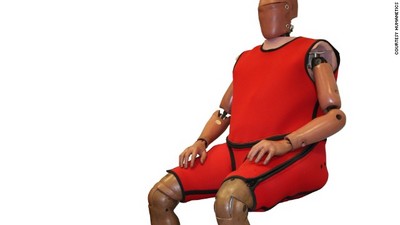The New Humanetics Obese Crash Test Dummy Offers the Automotive Industry a New Tool to Help Evaluate Occupant Safety
 |
Humanetics is committed to our corporate mission of developing products that ultimately save lives!
PLYMOUTH, MI -- December 11, 2014: With the obesity rate growing worldwide, and with industry statistics confirming that obese drivers are significantly more likely to die in an automobile crash, Humanetics has introduced an Obese Crash Test Dummy to help automotive suppliers improve safety for these larger sized occupants.
“By offering an obese crash test dummy that represents a large proportion of the population; Humanetics fully supports the automotive safety industry in their design efforts to make automobiles safer for everyone.”
In 1980 the average adult obesity rate in the United States was 15%. Today obesity has increased considerably to nearly 40% of the adult population. Obese drivers are up to 78% more likely to die in a car crash than normal weight occupants, according to a recent study from University of California Berkeley School of Public Health and the Institute of Transportation Studies. Among the obese, the higher the Body Mass Index (BMI), the more likely they will die in a crash.
“We’re still testing with a crash test dummy that weighs 170 pounds and was created with anthropometry studies from the 1980’s. Most systems in current automobiles are designed around these 1980’s standards. With an obese population in the United States of 40%, this 170 pound dummy is no longer representative of the current driving population,” Humanetics’ CEO, Christopher O’Connor, told USA Today. The dynamic differences seen in larger subjects and how effectively automobile safety devices respond to the additional size and mass of its occupants, is becoming more relevant in today’s world.
The first of its kind, Humanetics’ Obese Crash Test Dummy is based on the measurements of a 273-pound person with a Body Mass Index (BMI) of 35. Christopher O’Connor told CNN, “By offering an obese crash test dummy that represents a large proportion of the population; Humanetics fully supports the automotive safety industry in their design efforts to make automobiles safer for everyone.” The product has been tested and will be available for broad use in early 2015. The dummy is built around an existing fiftieth percentile male crash test dummy’s skeletal structure but with unique flesh and additional mass added to the upper and lower torso and upper legs, making it anatomically relevant to the obese driving population.
In cooperation with the University of Virginia, the obese dummy was verified in a series of belted sled tests designed to record the kinematic responses of the obese ATD prototype in order to compare it with available data sets from Post Mortem Human Subjects (PMHS). The preliminary analysis confirms that the obese dummy’s seated posture translates further forward on the seat compared to a non-obese occupant and changes the seat belt positioning, thereby creating new challenges for effective restraint countermeasures and knee impact protection.
Humanetics is now making the Obese Crash Test Dummy prototype available to the automotive industry to evaluate and compare data.


